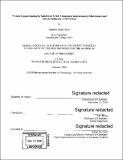Protein-ligand binding by solid-state NMR : cholesterol interactions in membranes and with the Influenza A M2 protein
Author(s)
Elkins, Matthew Ryan.
Download1199082922-MIT.pdf (34.51Mb)
Other Contributors
Massachusetts Institute of Technology. Department of Chemistry.
Advisor
Mei Hong.
Terms of use
Metadata
Show full item recordAbstract
Biological membranes and their have significant influence over normal cell functions and disease pathologies. Solid-state nuclear magnetic resonance (SSNMR) spectroscopy has historically been used to study membranes, which are constantly changing heterogenous systems. SSNMR can obtain atomic- and molecular-level information on molecular structure and dynamics within lipid bilayers, making it the ideal choice for studying the interactions at the heart of membrane and membrane protein functions. We focus on two membrane denizens: the influenza A M2 protein and the animal sterol cholesterol. M2 resides in the viral envelope and plays a key role in enabling viral entry to and release from the cell. M2-mediated viral release is a cholesterol-dependent process hypothesized to involve direct binding of cholesterol to a C-terminal amphipathic helix. Using ²H, ¹³C, and ¹⁹F-detected SSNMR experiments for measuring orientation and intermolecular contacts, we determined that cholesterol binds to the transmembrane helix of M2 rather than the amphipathic helix. Even in membranes with ~45 mol% cholesterol, similar to that of the viral envelope, M2' only binds ~2 cholesterol per tetramer. This behavior is consistent with M2's known localization to the edge of budding viruses and suggests that cholesterol binding is a mechanism to recruit and maintain sufficient M2 concentrations for membrane curvature induction and scission. Using ¹³C and ¹⁹F experiments we show that cholesterol forms oligomers both within the same bilayer leaflet and across the membrane. Even at fairly low cholesterol concentrations, cholesterol dimers are the most prevalent species; at high cholesterol concentrations, cholesterol can form clusters of four or more molecules in size. Preferential interactions between faces of cholesterol suggest that cholesterol-protein interactions are more likely to occur through the methyl-rich cholesterol face. The self-association properties of cholesterol be able to facilitate membrane protein association and oligomerization. We also used ¹³C and ¹⁵N NMR to address the structural cause for the enhanced pathogenicity of A[beta]₄₀ fibrils of the familial Arctic mutant compared to wild-type fibrils. Not only were Arctic fibrils intrinsically polymorphic, one of its major forms closely resembled wildtype A[beta]₄₂,which is known to form fibrils more rapidly and cause earlier-onset Alzheimer's disease.
Description
Thesis: Ph. D., Massachusetts Institute of Technology, Department of Chemistry, 2020 Cataloged from the PDF of thesis. Includes bibliographical references.
Date issued
2020Department
Massachusetts Institute of Technology. Department of ChemistryPublisher
Massachusetts Institute of Technology
Keywords
Chemistry.